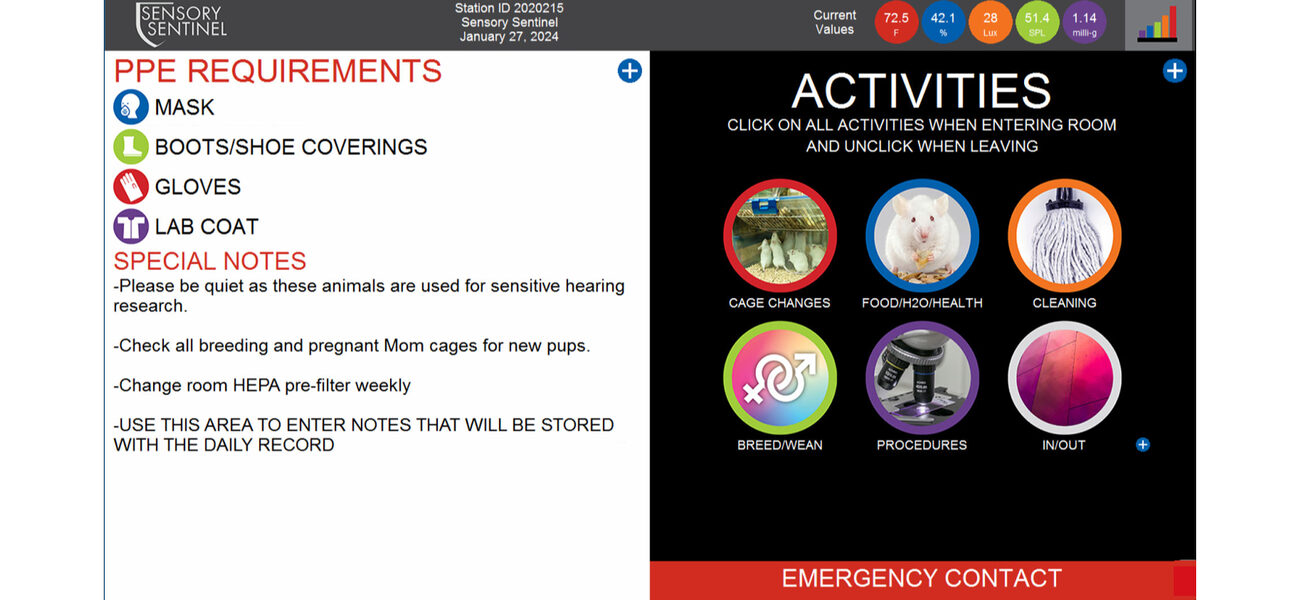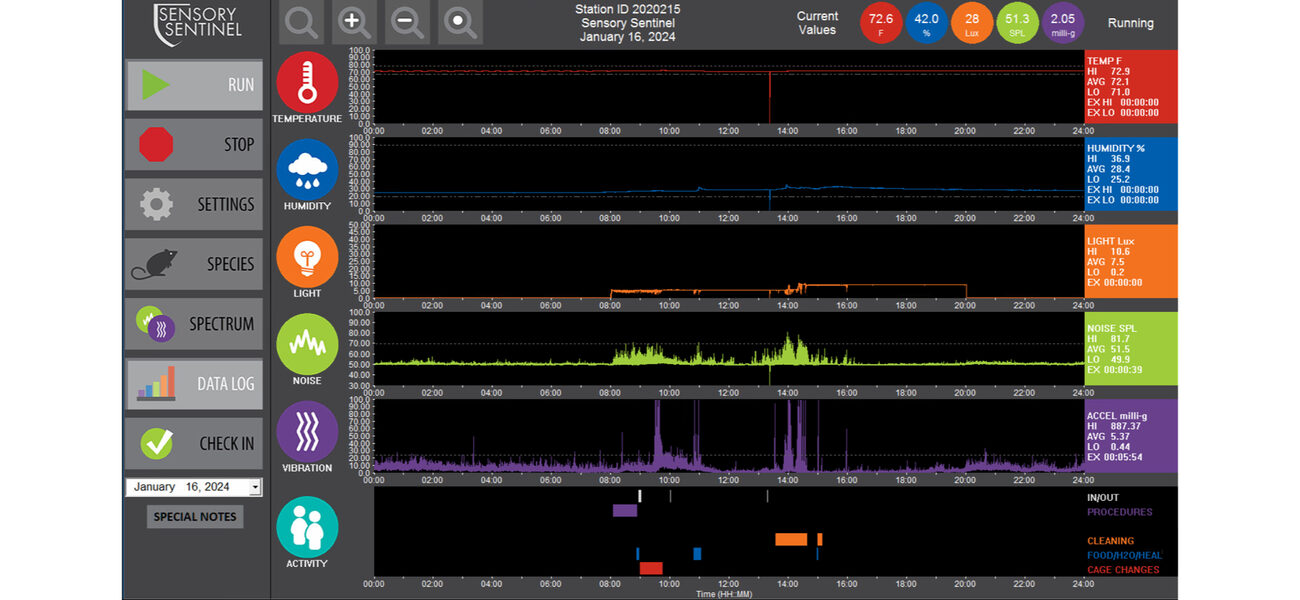The use of animals in biomedical research, already a decades-long ethically charged issue, has come under fire in more recent years for both a lack of scientific rigor and its huge financial appetite. Concerns about waste in basic research—in animal lives, scientist time, and research costs—are mounting, particularly when investigators are unable to confirm the data and achieve the same results when replicating original experiments (either theirs or others’).
The disquiet has entered the arena of legislative appropriations and swelled to what’s become widely regarded as a reproducibility crisis. After five years of working group studies, in September 2023 the National Institutes of Health (NIH) Council of Councils signaled strong support for a solution to the crisis by announcing funding for investigations into the effects of extrinsic environmental factors on the biological function of research animals.
Cindy Buckmaster, Ph.D., chief operating officer at Turner Scientific, regards this path as key in getting to the root cause of questionable, conflicting, or irreproducible data. She stresses how critical the influence of external elements—temperature, humidity, light, noise, and vibration, for example—can be to the outcome of any investigation.
“What is the source of our data?” she asks. “Animals! As we study these animals, we need to know what they are experiencing. What is happening with them that may be contributing to this reproducibility crisis?”
Noting that the work carried out in the realm of basic science is the foundation for later progress, she emphasizes, “The information must be as tight as possible. A practicable process to collect and store extrinsic data for review and evaluation is a necessary launch point for improving the accuracy of research findings.”
Trying to Understand Nature
Animal research is commonly misunderstood or poorly defined, says Buckmaster, pointing in particular to the way it is often characterized as idle curiosity in animal rights circles. Critics often compare the drug discovery process to other major scientific achievements like landing astronauts on the moon or packing a colossal amount of computing power into a cell phone. They bolster their arguments with the question, “Why, when it demands so many resources, is animal testing still necessary?”
Statistics can be used to support this view. According to a 2015 report from the NIH’s National Center for Advancing Translational Sciences, “a novel intervention can take about 14 years and $2 billion to develop, with a failure rate exceeding 95 percent.”
But that only tells part of the story.
For one thing, there is no doubt about the validity of animals as models for human translation, and there is not likely to be a replacement soon. Says Buckmaster, “This is not an issue.” As testimony to the biological conservation across species, she mentions medical successes that range from the 33 percent drop in U.S. cancer deaths from 1991 to 2023 to the 47 percent decline in AIDS-related mortality rates for men and boys from 2010 to 2023.
Delving deeper, the fundamental reason why animal research is both pivotal and complex traces back to a significant distinction in the types of problems researchers are trying to solve. Analogies to massive undertakings like the moon shot overlook a fundamental difference between the fields of endeavor.
“In order to understand why something doesn’t work, you have to first understand how it’s put together when it’s functioning properly on every level,” explains Buckmaster. “Humans created mechanical systems, so we know how they function. But we did not create biological systems. We just are biological systems, and we’re still figuring out how they work. We’re trying to understand nature.”
The Process
Reframing the discussion, Buckmaster points out that the vast majority of work with animals falls into the basic research category, where chunks of foundational knowledge about human biological systems are still missing. Basic research provides clues to the way the various systems function.
“All the published research to date concerns some small aspect of how every little system works. It’s a collection of clues, and at some point, there’s enough information that the folks on the applied side of things put the clues together and think about what kind of compound to develop to help treat a disease.”
The bulk of the testing for these experimental compounds, before they’re released to market, happens in people, not animals, in the three phases of clinical trials.
“You cannot test an experimental compound in human volunteers until you screen it for whether or not it’s safe,” she notes. “That is where animals come in, and it’s a much smaller piece of the equation.”
The basic research conclusions are vital, but the results are frequently inaccurate. One survey found that researchers couldn’t reproduce someone else’s study roughly 70 percent of the time, and half the researchers also said they couldn’t reproduce their own.
“If the studies can’t be reproduced in pharma and they can’t go any further, we just wasted a lot of time, a lot of money, and most importantly, a lot of animals’ lives,” says Buckmaster.
The Animal Experience
Changes in planning and reporting guidelines have led to improvements in study design and greater transparency, but they fail to address one of the root causes of irreproducible data: the lack of information about the extrinsic factors that may have affected animal physiology during the investigation.
Animal sensitivities to external conditions—whether vibration, sound, temperature, bedding, or any number of other environmental influences—are very different from humans’. These sensitivities are very likely to influence the outcome of an investigation.
Buckmaster cites rodents, the predominant species used in research, as an example. As nocturnal, burrowing animals, mice and rats are very light sensitive; living in the dark, they rely on ultrasonic communications with conspecifics and are highly tuned to vibration.
“A vibration event can put the rodent in survival mode, changing its physiology,” she says. “It’s not a slight thing. Humans are not aware of these stressors because we don’t perceive them in the range that the animals perceive them.” She also cautions that some things that bother humans, like construction noise, may fall outside the sensory range of a particular species and thus have no affect at all.
Zebrafish are another biomedical model with particular sensitivities to extrinsic factors. Their lateral line system is a sensory organ that collects vital information about sound and vibration, governing how they move in the water for orientation, schooling, and predator defense. Noise and vibration, and the ability to detect them, are critical to their survival. They can also have a negative effect on reproduction. Studies have found a link between various ranges of noise and vibration and inverted organ growth and neural tube defects in zebrafish embryos.
“Noise and vibration events can lead to a tremendous amount of stress in these animals, as they get into fight-or-flight mode,” explains Buckmaster.
Consequences range from changes in heart rate, difficulty breathing, and weight loss, to altered sleep cycles. When their stress pathways are excited, it is not good time to collect information from these animals.
“With situations like this that we aren’t accounting for, no wonder there are differences between what I’m getting in my data and what someone else is getting in their data. Low reproducibility means we have to use more animals to get a statistical finding because everything is so noisy. None of this is good for animals or science.”
“What Gets Measured…”
One of the recommendations in the July 2021 final report of NIH’s ACD (Advisory Committee to the Director) Working Group on Enhancing Rigor, Transparency, and Translatability in Animal Research calls for NIH to “encourage and support work to better understand, monitor, record, and report important extrinsic factors related to animal care that may affect research results.”
Consistent with the time-tested axiom that “what gets measured gets improved,” a package of data-collection tools, software, and processes has been developed to do those very things.
Turner Scientific’s Sensory Sentinel measures and interprets all the environmental variables that can affect the animal experience: light, temperature, humidity, noise, vibration, and human activity.
Sentinel system sensors can be placed directly in the cage, not just at the room level, in order to create a precise record of what the animal actually experiences.
Equally important, the system can be tuned to the perceptual range of the species being studied. Thresholds for the extrinsic factors identified in the Guide for the Care and Use of Laboratory Animals are built into the software, as are exceedance indicators and alarming capabilities.
The device also detects the presence of ultrasound, a major disruptor of animal physiology, even causing seizures or deafness in mice. Common sources are computers, battery backup units, and, especially, failing rack motors and ultrasonic motion sensors.
As it logs and stores data second by second around the clock, the system accumulates a complete history of the animal experience, with every activity recorded. This pivotal feature is extremely helpful in the case of anomalous data. A researcher can go into the system calendar to look for events on the timeline that might be connected to the adverse results.
“We cannot keep ignoring the way extrinsic factors impact data collected from animals,” summarizes Buckmaster. “This information matters for anyone who wants to do something with that data, especially for a pharmaceutical company using the findings about a particular system to develop a drug to treat it. It’s essential to know how pure the information is.
“A measurement system will help us reach the desired outcome: ‘stronger science, faster cures, and fewer animals,’” she concludes.
By Nicole Zaro Stahl


